Film Mulching Enhances Wheat Productivity in Tilled Systems but Not in No-Till Systems by Differentially Regulating Root-Zone Temperature During the Spring Season in the North China Plain
Abstract
1. Introduction
2. Materials and Methods
2.1. Research Experimental Area Description
2.2. Main Experimental Plot Design
2.3. Split-Plot Experimental Design
2.4. Monitoring the Soil Temperature (ST) and Soil Moisture Level
2.5. Measurements of Crop Roots and Aboveground Dry Matter (AGDM)
2.6. Estimation of Crop Yield Attributes
2.7. Analysis of Data
3. Results
3.1. Climate Data
3.2. ST
3.2.1. Dynamics of ST in the 0–40 cm Soil Layer
3.2.2. Averaged STs at 0–40 cm
3.2.3. Averaged STs at Different Soil Depths
3.2.4. Soil-Accumulated Temperature (SAT)
3.3. Effects of STs on Root Characteristics (RCs)
3.3.1. Improvement in Root Length Density (RLD) and Root Weight Density (RWD)
3.3.2. Influence on Root Surface Area (RSA)
3.3.3. Root Volume (RV) and Root Diameter (RD) Response to STs
3.4. Effects of Soil Moisture Content (SMC) at Different Growth Stages
3.5. Response of Crop Yield Attributes and Aboveground Dry Matter (AGDM)
3.6. Multivariate Principal Component Analysis (PCA) to Tillge Systems and PFM
4. Discussion
4.1. Impact of Tillage and PFM on Soil Temperature During the Overwintering Period
4.2. Root Characteristics Response to PFM and Tillage System
4.3. RC Enhanced Yield and Yield Parameters
4.4. Relationships Among the ST, RC, and Yield Agronomical Parameters
5. Conclusions
Supplementary Materials
Author Contributions
Funding
Data Availability Statement
Conflicts of Interest
References
- Plaza, C.; Courtier-Murias, D.; Fernández, J.M.; Polo, A.; Simpson, A.J. Physical, chemical, and biochemical mechanisms of soil organic matter stabilization under conservation tillage systems: A central role for microbes and microbial by-products in C sequestration. Soil. Biol. Biochem. 2012, 57, 124–134. [Google Scholar] [CrossRef]
- Licht, M.A.; Al-Kaisi, M. Strip-tillage effect on seedbed soil temperature and other soil physical properties. Soil. Tillage Res. 2004, 80, 233–249. [Google Scholar] [CrossRef]
- Gan, Y.; Siddique, K.H.M.; Turner, N.C.; Li, X.-G.; Niu, J.-Y.; Yang, C.; Liu, L.; Chai, Q. Ridge-Furrow Mulching Systems—An innovative technique for boosting crop productivity in semiarid Rain-Fed environments. In Advances in agronomy; Elsevier: Amsterdam, The Netherlands, 2012; pp. 429–476. [Google Scholar] [CrossRef]
- Du, X.; Zhang, W.-H.; Zhang, Y.-S.; Cao, C.-Y.; Li, K.-J. Artificial Warming from Late Winter to Early Spring by Phased Plastic Mulching Increases Grain Yield of Winter Wheat. ACTA Agron. Sin. 2016, 42, 1530. [Google Scholar] [CrossRef]
- Kassam, A.; Friedrich, T.; Derpsch, R.; Kienzle, J. Overview of the Worldwide Spread of Conservation Agriculture. Available online: https://doaj.org/article/5ebd222c01734909b194ec21684a1c96 (accessed on 5 April 2025).
- Li, R.; Hou, X.; Jia, Z.; Han, Q.; Ren, X.; Yang, B. Effects on soil temperature, moisture, and maize yield of cultivation with ridge and furrow mulching in the rainfed area of the Loess Plateau, China. Agric. Water Manag. 2012, 116, 101–109. [Google Scholar] [CrossRef]
- Wang, E.; Martre, P.; Zhao, Z.; Ewert, F.; Maiorano, A.; Rötter, R.P.; Kimball, B.A.; Ottman, M.J.; Wall, G.W.; White, J.W.; et al. The uncertainty of crop yield projections is reduced by improved temperature response functions. Nat. Plants 2017, 3, 17102. [Google Scholar] [CrossRef]
- Wang, Y.; Xie, Z.; Malhi, S.S.; Vera, C.L.; Zhang, Y.; Wang, J. Effects of rainfall harvesting and mulching technologies on water use efficiency and crop yield in the semi-arid Loess Plateau, China. Agric. Water Manag. 2008, 96, 374–382. [Google Scholar] [CrossRef]
- Wu, L.; Quan, H.; Wu, L.; Zhang, X.; Feng, H.; Ding, D.; Siddique, K.H.M. Responses of winter wheat yield and water productivity to sowing time and plastic mulching in the Loess Plateau. Agric. Water Manag. 2023, 289, 108572. [Google Scholar] [CrossRef]
- Steinmetz, Z.; Wollmann, C.; Schaefer, M.; Buchmann, C.; David, J.; Tröger, J.; Muñoz, K.; Frör, O.; Schaumann, G.E. Plastic mulching in agriculture. Plastic mulching in agriculture. Trading short-term agronomic benefits for long-term soil degradation? Sci. Total Environ. 2016, 550, 690–705. [Google Scholar] [CrossRef] [PubMed]
- Bu, L.; Zhu, L.; Liu, J.; Luo, S.; Chen, X.; Li, S. Source–Sink Capacity Responsible for Higher Maize Yield with Removal of Plastic Film. Agron. J. 2013, 105, 591–598. [Google Scholar] [CrossRef]
- Loughrin, J.H.; Kasperbauer, M.J. Aroma of Fresh Strawberries Is Enhanced by Ripening over Red versus Black Mulch. J. Agric. Food Chem. 2001, 50, 161–165. [Google Scholar] [CrossRef] [PubMed]
- Moreno, M.M.; Moreno, A. Effect of different biodegradable and polyethylene mulches on soil properties and production in a tomato crop. Sci. Hortic. 2008, 116, 256–263. [Google Scholar] [CrossRef]
- Anikwe, M.A.N.; Mbah, C.N.; Ezeaku, P.I.; Onyia, V.N. Tillage and plastic mulch effects on soil properties and growth and yield of cocoyam (Colocasia esculenta) on an ultisol in southeastern Nigeria. Soil. Tillage Res. 2006, 93, 264–272. [Google Scholar] [CrossRef]
- Ricotta, J.A.; Masiunas, J.B. The effects of black plastic mulch and weed control strategies on herb yield. HortScience 1991, 26, 539–541. [Google Scholar] [CrossRef]
- Eldoma, I.M.; Li, M.; Zhang, F.; Li, F.-M. Alternate or equal ridge–furrow pattern: Which is better for maize production in the rain-fed semi-arid Loess Plateau of China? Field Crops Res. 2016, 191, 131–138. [Google Scholar] [CrossRef]
- Mo, F.; Wang, J.-Y.; Xiong, Y.-C.; Nguluu, S.N.; Li, F.-M. Ridge-furrow mulching system in semiarid Kenya: A promising solution to improve soil water availability and maize productivity. Eur. J. Agron. 2016, 80, 124–136. [Google Scholar] [CrossRef]
- Ye, J.; Gao, Z.; Wu, X.; Lu, Z.; Li, C.; Wang, X.; Chen, L.; Cui, G.; Yu, M.; Yan, G.; et al. Impact of increased temperature on spring wheat yield in northern China. Food Energy Secur. 2021, 10, 368–378. [Google Scholar] [CrossRef]
- Chen, S.; Yang, P.; Zhang, Y.; Dong, W.; Hu, C.; Oenema, O. Responses of cereal yields and soil carbon sequestration to four Long-Term Tillage practices in the North China Plain. Agronomy 2022, 12, 176. [Google Scholar] [CrossRef]
- Du, Z.; Ren, T.; Hu, C. Tillage and residue removal effects on soil carbon and nitrogen storage in the North China Plain. Soil. Sci. Soc. Am. J. 2010, 74, 196–202. [Google Scholar] [CrossRef]
- Dong, W.; Hu, C.; Chen, S.; Zhang, Y. Tillage and residue management effects on soil carbon and CO2 emission in a wheat–corn double-cropping system. Nutr. Cycl. Agroecosystems 2008, 83, 27–37. [Google Scholar] [CrossRef]
- Yu, C.; Mawodza, T.; Atkinson, B.S.; Atkinson, J.A.; Sturrock, C.J.; Whalley, R.; Hawkesford, M.J.; Cooper, H.; Zhang, X.; Zhou, H.; et al. The effects of soil compaction on wheat seedling root growth are specific to soil texture and soil moisture status. Rhizosphere 2023, 29, 100838. [Google Scholar] [CrossRef]
- Pittelkow, C.M.; Liang, X.; Linquist, B.A.; Van Groenigen, K.J.; Lee, J.; Lundy, M.E.; Van Gestel, N.; Six, J.; Venterea, R.T.; Van Kessel, C. Productivity limits and potentials of the principles of conservation agriculture. Nature 2014, 517, 365–368. [Google Scholar] [CrossRef]
- Wu, H.; Timilsina, A.; Chen, S.; Li, X.; Zhang, Y.; Hu, C.; Dong, W. Long-term conservation tillage practices affect total carbon and contribute to the formation of soil aggregates in the semi-arid North China Plain. Soil Use Manag. 2024, 40. [Google Scholar] [CrossRef]
- Chimento, C.; Amaducci, S. Characterization of fine root system and potential contribution to soil organic carbon of six perennial bioenergy crops. Biomass Bioenergy 2015, 83, 116–122. [Google Scholar] [CrossRef]
- Mosaddeghi; Mahboubi, A.A.; Safadoust, A. Short-term effects of tillage and manure on some soil physical properties and maize root growth in a sandy loam soil in western Iran. Soil. Tillage Res. 2008, 104, 173–179. [Google Scholar] [CrossRef]
- Yang, J.; Qin, R.; Shi, X.; Wei, H.; Sun, G.; Li, F.-M.; Zhang, F. The effects of plastic film mulching and straw mulching on licorice root yield and soil organic carbon content in a dryland farming. Sci. Total Environ. 2022, 826, 154113. [Google Scholar] [CrossRef]
- Zhang, F.; Zhang, W.; Qi, J.; Li, F.-M. A regional evaluation of plastic film mulching for improving crop yields on the Loess Plateau of China. Agric. For. Meteorol. 2017, 248, 458–468. [Google Scholar] [CrossRef]
- O’Brien, P.L.; Daigh, A.L.M. Tillage practices alter the surface energy balance—A review. Soil. Tillage Res. 2019, 195, 104354. [Google Scholar] [CrossRef]
- Porter, J.R.; Gawith, M. Temperatures and the growth and development of wheat: A review. Eur. J. Agron. 1999, 10, 23–36. [Google Scholar] [CrossRef]
- Qin, X.; Li, Y.; Han, Y.; Hu, Y.; Li, Y.; Wen, X.; Liao, Y.; Siddique, K.H.M. Ridge-furrow mulching with black plastic film improves maize yield more than white plastic film in dry areas with adequate accumulated temperature. Agric. For. Meteorol. 2018, 262, 206–214. [Google Scholar] [CrossRef]
- Liu, J.; Zhan, A.; Bu, L.; Zhu, L.; Luo, S.; Chen, X.; Cui, Z.; Li, S.; Hill, R.L.; Zhao, Y. Understanding dry matter and nitrogen accumulation for High-Yielding Film-Mulched Maize. Agron. J. 2014, 106, 390–396. [Google Scholar] [CrossRef]
- Chen, H.; Hou, R.; Gong, Y.; Li, H.; Fan, M.; Kuzyakov, Y. Effects of 11 years of conservation tillage on soil organic matter fractions in wheat monoculture in Loess Plateau of China. Soil. Tillage Res. 2009, 106, 85–94. [Google Scholar] [CrossRef]
- Drury, C.F.; Tan, C.; Welacky, T.W.; Oloya, T.O.; Hamill, A.S.; Weaver, S.E. Red clover and tillage influence on soil temperature, water content, and corn emergence. Agron. J. 1999, 91, 101–108. [Google Scholar] [CrossRef]
- Subrahmaniyan, K.; Zhou, W. Soil Temperature Associated with Degradable, Non-Degradable Plastic and Organic Mulches and Their Effect on Biomass Production, Enzyme Activities and Seed Yield of Winter Rapeseed (Brassica napus L.). J. Sustain. Agric. 2008, 32, 611–627. [Google Scholar] [CrossRef]
- Wu, Y.; Perry, K.B.; Ristaino, J.B. Estimating temperature of mulched and bare soil from meteorological data. Agric. For. Meteorol. 1996, 81, 299–323. [Google Scholar] [CrossRef]
- Chen, S.Y.; Zhang, X.Y.; Pei, D.; Sun, H.Y.; Chen, S.L. Effects of straw mulching on soil temperature, evaporation and yield of winter wheat: Field experiments on the North China Plain. Ann. Appl. Biol. 2007, 150, 261–268. [Google Scholar] [CrossRef]
- Yin, W.; Chai, Q.; Guo, Y.; Fan, H.; Fan, Z.; Hu, F.; Zhao, C.; Yu, A.; Coulter, J.A. No tillage with plastic re-mulching maintains high maize productivity via regulating hydrothermal effects in an arid region. Front. Plant Sci. 2021, 12, 649684. [Google Scholar] [CrossRef]
- Zapata, D.; Rajan, N.; Mowrer, J.; Casey, K.; Schnell, R.; Hons, F. Long-term tillage effect on with-in season variations in soil conditions and respiration from dryland winter wheat and soybean cropping systems. Sci. Rep. 2021, 11, 2344. [Google Scholar] [CrossRef]
- Sun, S.; Chen, Z.; Jiang, H.; Zhang, L. Black film mulching and plant density influencing soil water temperature conditions and maize root growth. Vadose Zone J. 2018, 17, 1–12. [Google Scholar] [CrossRef]
- Qi, Z.; Zhang, T.; Zhou, L.; Feng, H.; Zhao, Y.; Si, B. Combined Effects of Mulch and Tillage on Soil Hydrothermal Conditions under Drip Irrigation in Hetao Irrigation District, China. Water 2016, 8, 504. [Google Scholar] [CrossRef]
- Gao, Y.; Xie, Y.; Jiang, H.; Wu, B.; Niu, J. Soil water status and root distribution across the rooting zone in maize with plastic film mulching. Field Crops Res. 2013, 156, 40–47. [Google Scholar] [CrossRef]
- Li, Y.; Yang, J.; Shi, Z.; Pan, W.; Liao, Y.; Li, T.; Qin, X. Response of root traits to plastic film mulch and its effects on yield. Soil. Tillage Res. 2021, 209, 104930. [Google Scholar] [CrossRef]
- Li, Q.; Li, H.; Zhang, L.; Zhang, S.; Chen, Y. Mulching improves yield and water-use efficiency of potato cropping in China: A meta-analysis. Field Crops Res. 2018, 221, 50–60. [Google Scholar] [CrossRef]
- Yin, W.; Chai, Q.; Guo, Y.; Feng, F.; Zhao, C.; Yu, A.; Hu, F. Analysis of Leaf Area Index Dynamic and Grain Yield Components of Intercropped Wheat and Maize under Straw Mulch Combined with Reduced Tillage in Arid Environments. J. Agric. Sci. 2016, 8, 26. [Google Scholar] [CrossRef]
- Dai, X.; Huo, Z.; Wang, H. Simulation for response of crop yield to soil moisture and salinity with artificial neural network. Field Crops Res. 2011, 121, 441–449. [Google Scholar] [CrossRef]
- Zhao, J.; Liu, Z.; Lai, H.; Zhao, M.; Zhu, Q.; Zhao, C.; Yang, D.; Li, X. The impacts of soil tillage combined with plastic film management practices on soil quality, carbon footprint, and peanut yield. Eur. J. Agr. 2023, 148, 126881. [Google Scholar] [CrossRef]
- Li, W.; Jin, C.; Guan, D.; Wang, Q.; Wang, A.; Yuan, F.; Wu, J. The effects of simulated nitrogen deposition on plant root traits: A meta-analysis. Soil. Biol. Biochem. 2015, 82, 112–118. [Google Scholar] [CrossRef]
- Zhang, G.; Hou, Y.; Zhang, H.; Fan, H.; Wen, X.; Han, J.; Liao, Y. Optimizing planting pattern and nitrogen application rate improves grain yield and water use efficiency for rain-fed spring maize by promoting root growth and reducing redundant root growth. Soil. Tillage Res. 2022, 220, 105385. [Google Scholar] [CrossRef]
- Song, Q.; Zhang, F.; Li, X.; Yue, S.; Luo, Z.; Li, S. Understanding of maize root responses to changes in water status induced by plastic film mulching cultivation on the Loess Plateau, China. Agric. Water Manag. 2024, 301, 108932. [Google Scholar] [CrossRef]
- Pregitzer, K.S.; King, J.S.; Burton, A.J.; Brown, S.E. Responses of tree fine roots to temperature. N. Phytol. 2000, 147, 105–115. [Google Scholar] [CrossRef]
- Hatfield, J.L.; Prueger, J.H. Temperature extremes: Effect on plant growth and development. Weather. Clim. Extrem. 2015, 10, 4–10. [Google Scholar] [CrossRef]
- Lal, R. Soil carbon sequestration impacts on global climate change and food security. Science 2004, 304, 1623–1627. [Google Scholar] [CrossRef]
- Lobell, D.B.; Schlenker, W.; Costa-Roberts, J. Climate trends and global crop production since 1980. Science 2011, 333, 616–620. [Google Scholar] [CrossRef] [PubMed]
- Fageria, N.K.; Moreira, A. The role of mineral nutrition on root growth of crop plants. In Advances in Agronomy; Elsevier: Amsterdam, The Netherlands, 2011; pp. 251–331. [Google Scholar] [CrossRef]
- Lynch, J.P. Steep, cheap and deep: An ideotype to optimize water and N acquisition by maize root systems. Ann. Bot. 2013, 112, 347–357. [Google Scholar] [CrossRef] [PubMed]
- Wasson, A.P.; Richards, R.A.; Chatrath, R.; Misra, S.C.; Prasad, S.V.S.; Rebetzke, G.J.; Kirkegaard, J.A.; Christopher, J.; Watt, M. Traits and selection strategies to improve root systems and water uptake in water-limited wheat crops. J. Exp. Bot. 2012, 63, 3485–3498. [Google Scholar] [CrossRef] [PubMed]
- Hammer, G.L.; Dong, Z.; McLean, G.; Doherty, A.; Messina, C.; Schussler, J.; Zinselmeier, C.; Paszkiewicz, S.; Cooper, M. Can changes in canopy and/or root system architecture explain historical maize yield trends in the U.S. Corn Belt? Crop Sci. 2009, 49, 299–312. [Google Scholar] [CrossRef]
- White, R.G.; Kirkegaard, J.A. The distribution and abundance of wheat roots in a dense, structured subsoil—Implications for water uptake. Plant Cell Environ. 2009, 33, 133–148. [Google Scholar] [CrossRef]
- Lynch, J.P. Root phenotypes for improved nutrient capture: An underexploited opportunity for global agriculture. N. Phytol. 2019, 223, 548–564. [Google Scholar] [CrossRef]
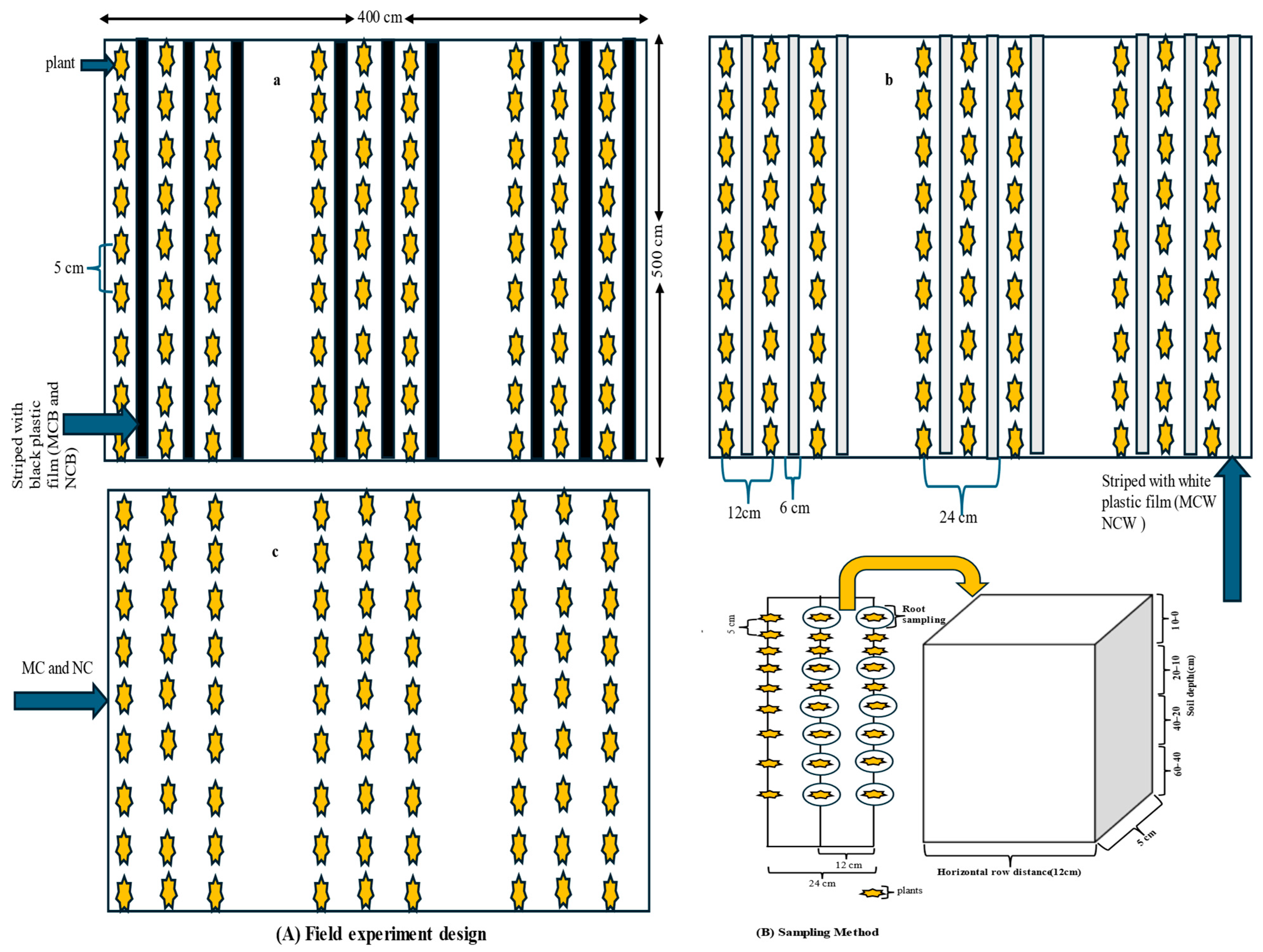
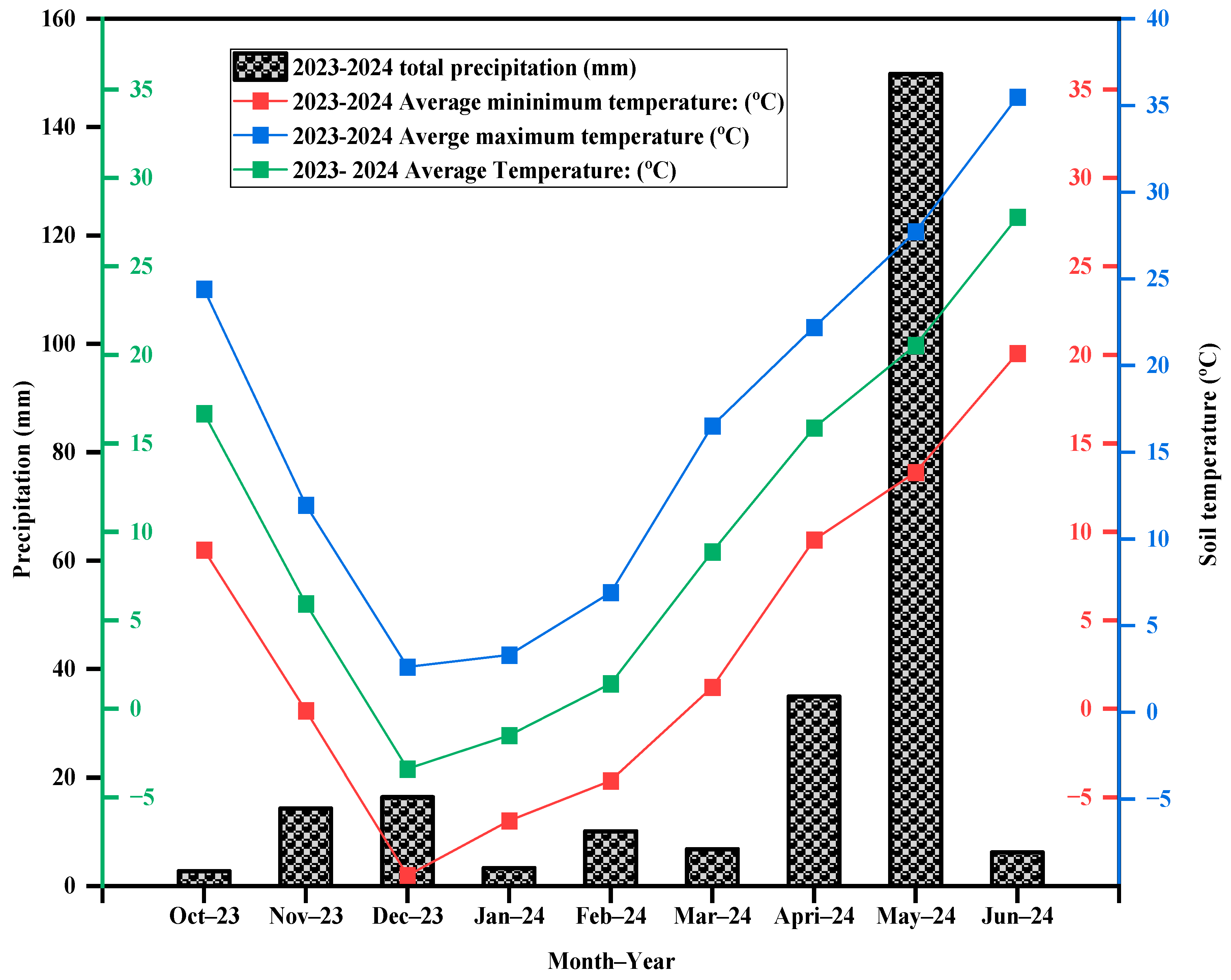
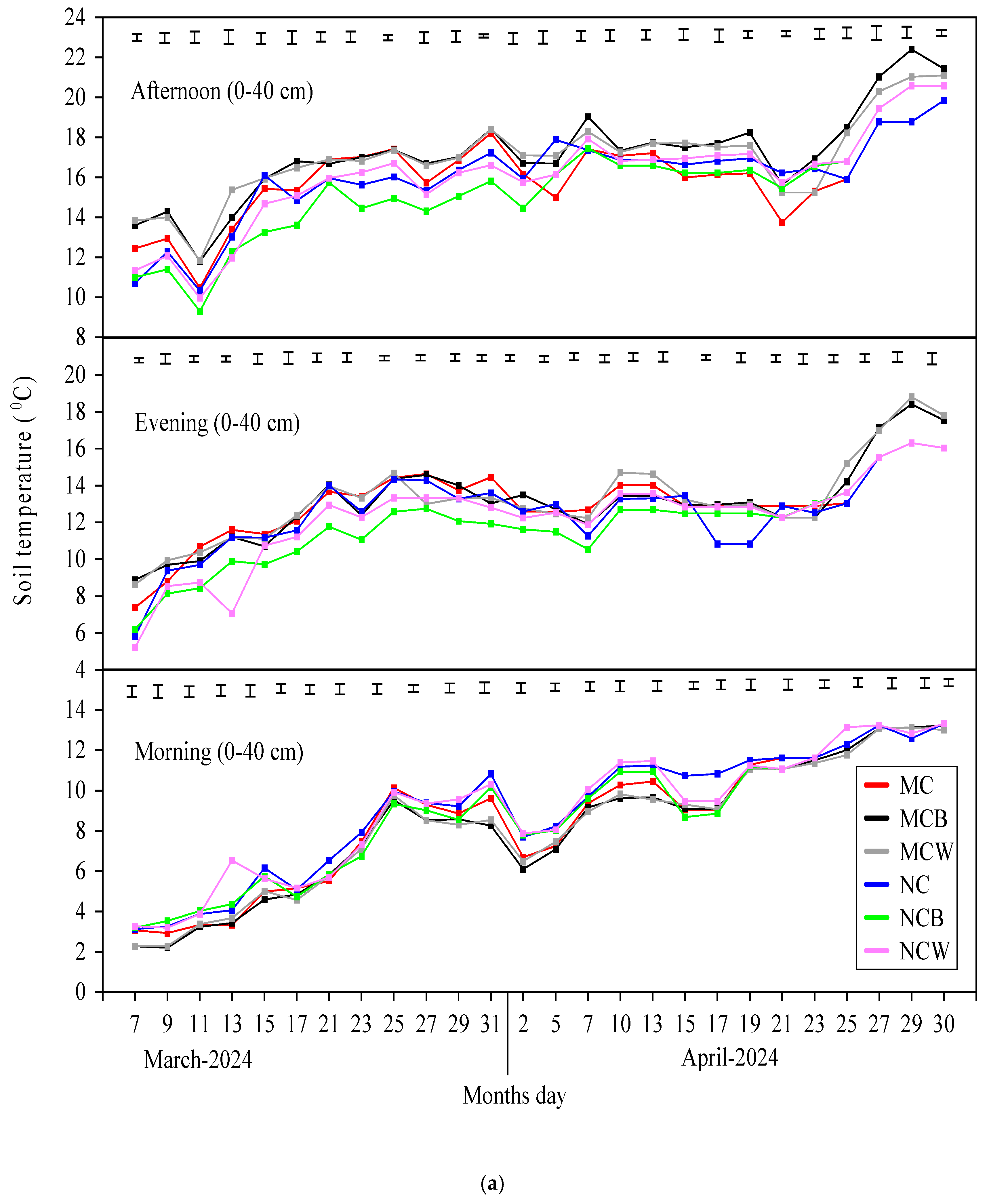

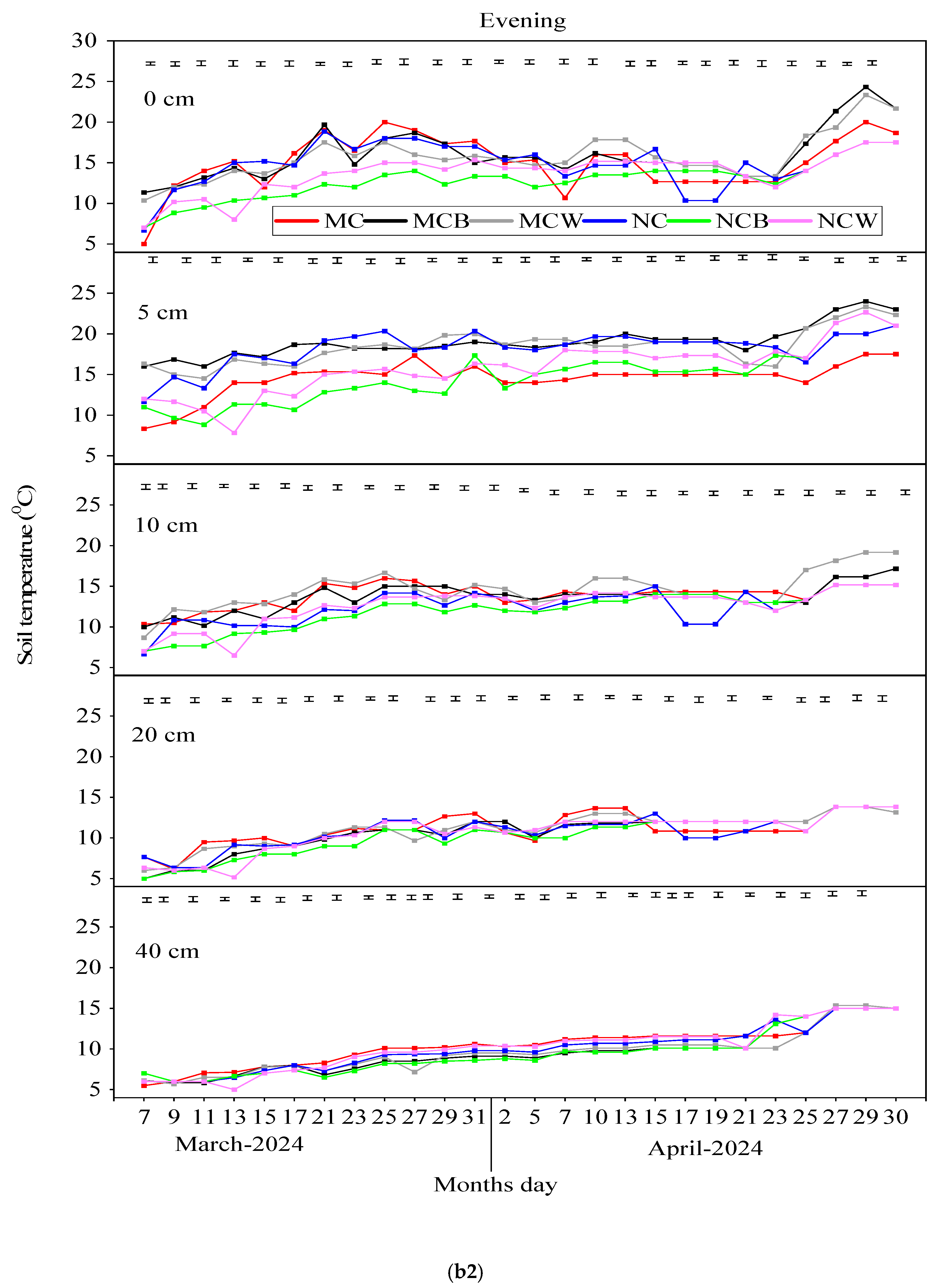
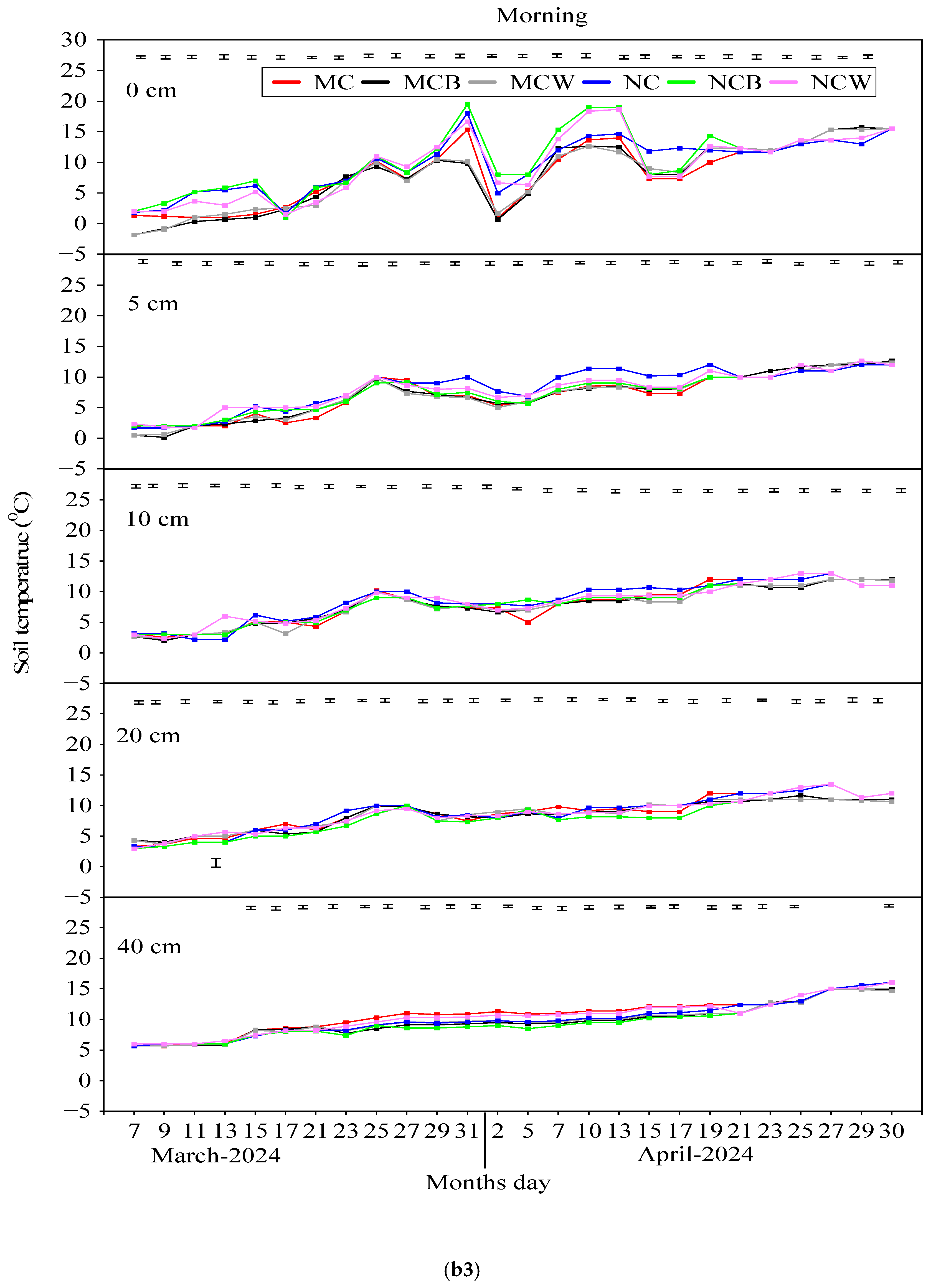
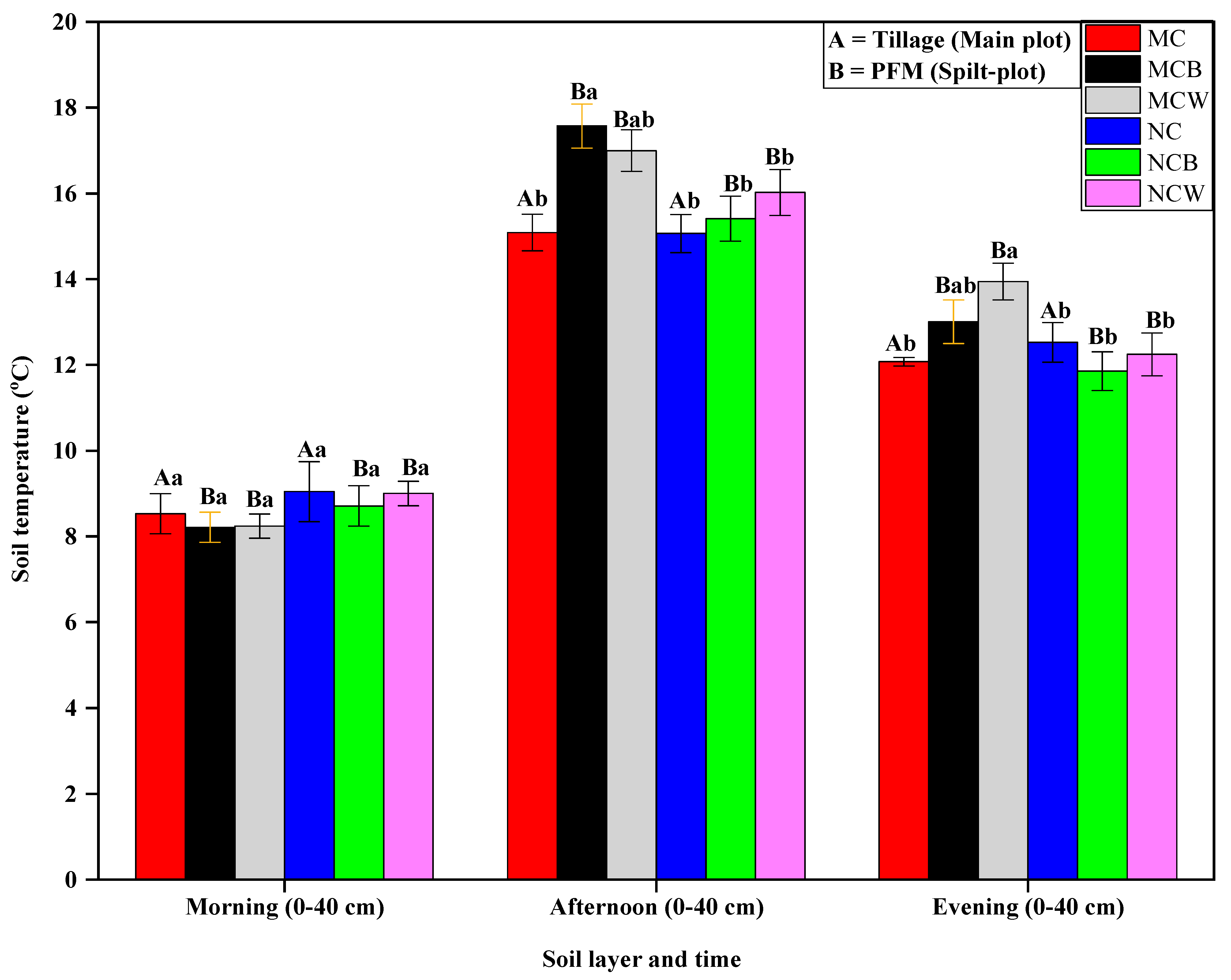
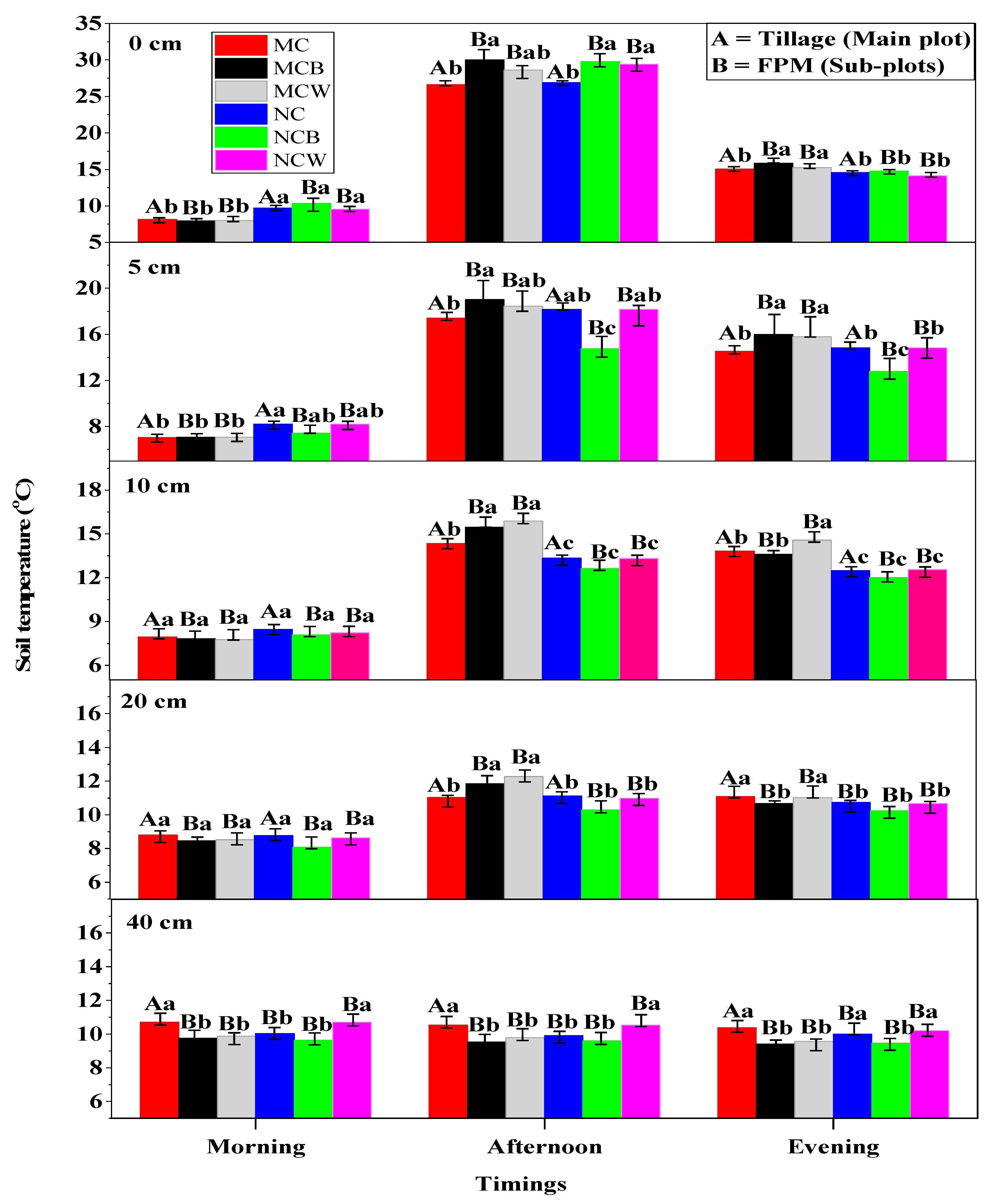

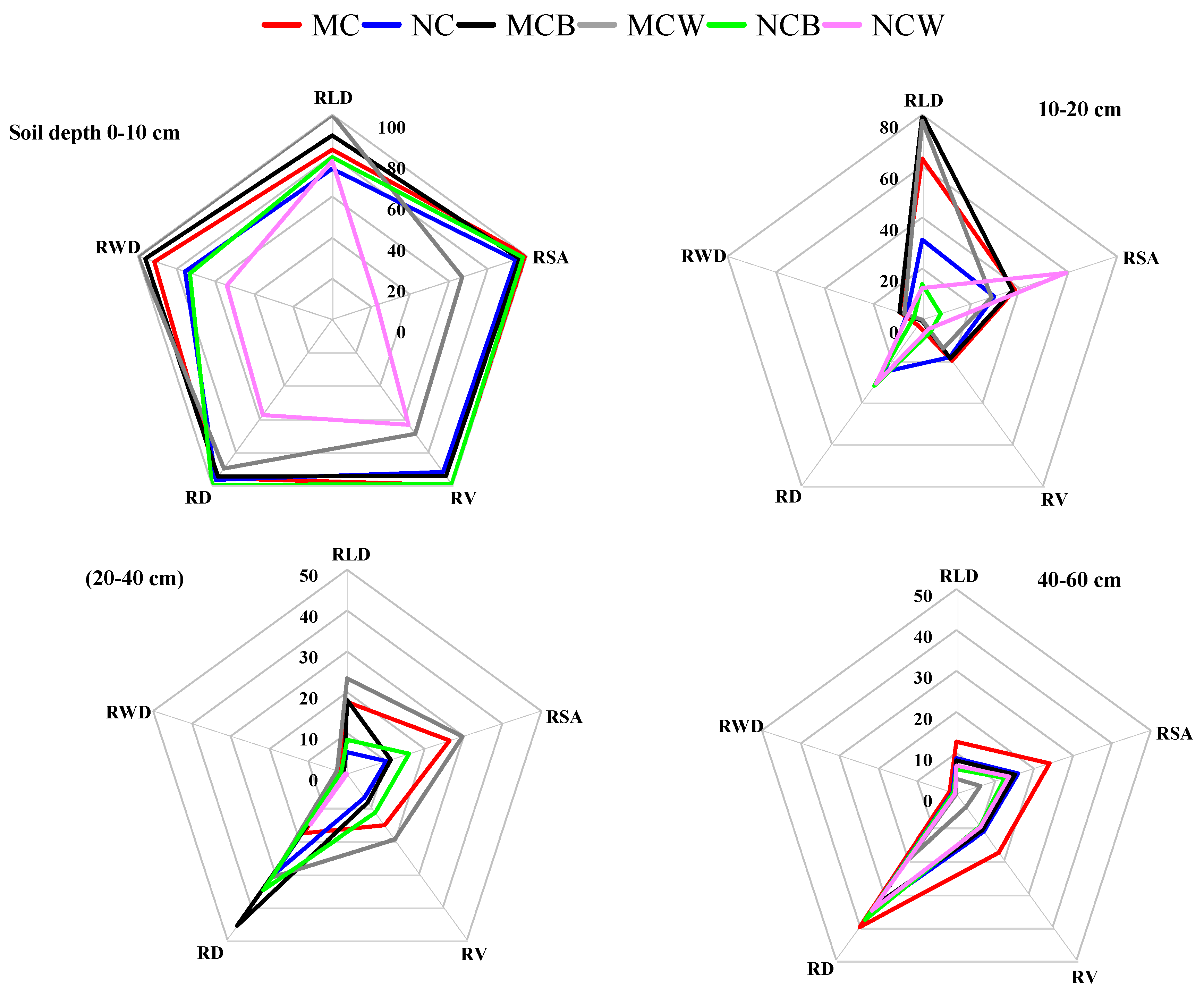

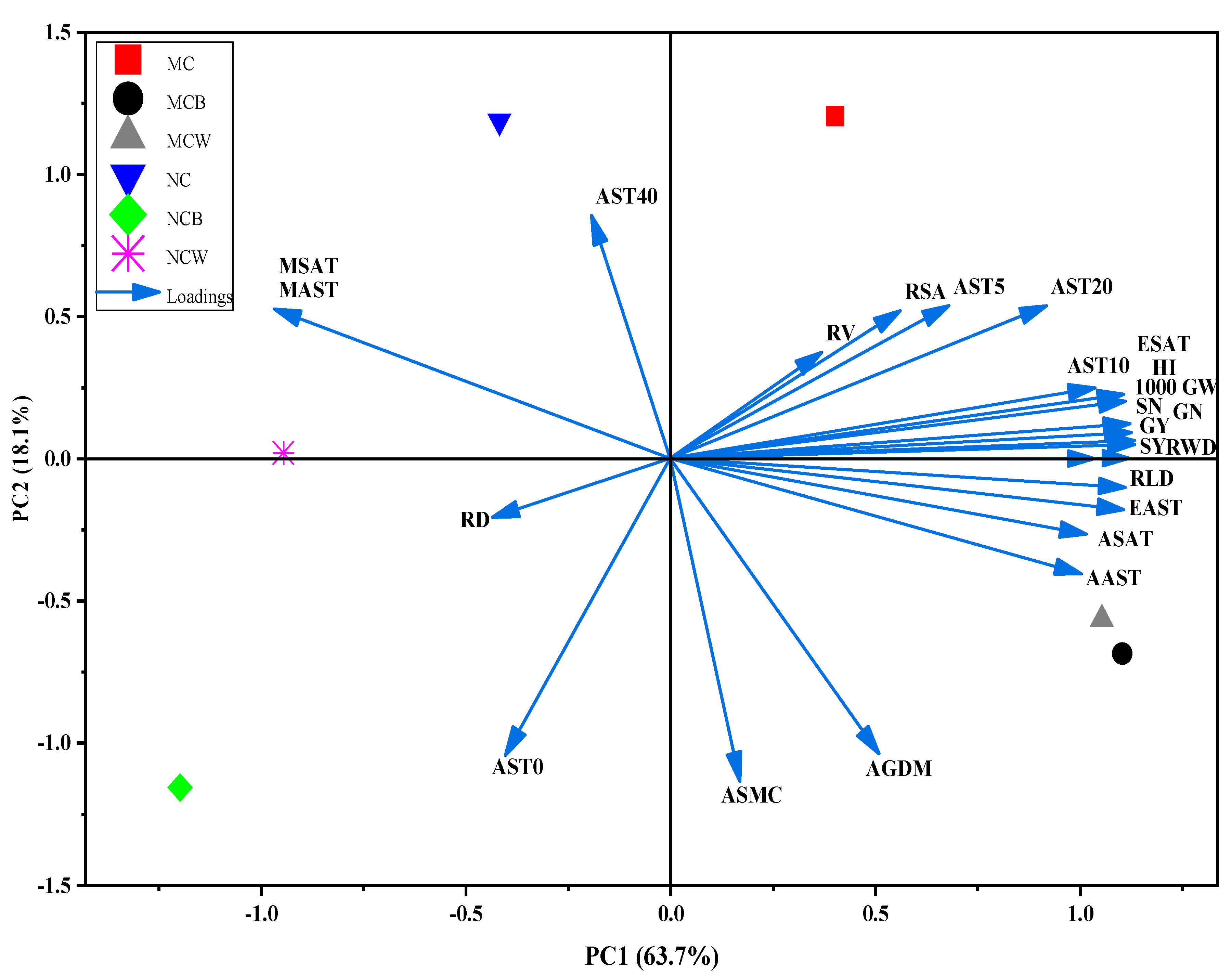
| Time | Treatments | Accumulated Soil Temperature (°C) | ||||
|---|---|---|---|---|---|---|
| Soil Depth (cm) | 0 | 5 | 10 | 20 | 40 | |
| Afternoon | MC | 588.00 Aa | 348.83 Ab | 268.83 Aa | 182.83 Ab | 170.13 Aa |
| MCB | 677.17 Ba | 391.23 Ba | 299.03 Bb | 205.17 Bb | 144.73 Bb | |
| MCW | 639.67 Bb | 375.67 Bb | 308.87 Ba | 215.15 Ba | 150.47 Bb | |
| NC | 595.17 Aa | 378.17 Aa | 243.17 Ab | 185.30 Aa | 153.73 Ab | |
| NCB | 670.00 Ba | 279.67 Bd | 224.33 Bd | 163.67 Bd | 145.80 Bb | |
| NCW | 661.50 Bab | 307.33 Bc | 242.17 Bc | 181.67 Bc | 170.18 Ba | |
| PFM | *** | *** | *** | *** | *** | |
| Tillage | ns | *** | *** | *** | ns | |
| Interaction | * | *** | *** | *** | *** | |
| Evening | MC | 287.67 Aa | 273.50 Ab | 255.67 Aa | 184.17 a | 165.90 Aa |
| MCB | 308.00 Ba | 311.50 Ba | 250.00 Bb | 173.67 d | 140.83 Bc | |
| MCW | 292.33 Bb | 306.33 Bb | 275.17 Ba | 182.67 b | 144.97 Bb | |
| NC | 274.83 Ab | 281.67 Aa | 220.80 Ab | 175.17 c | 155.89 Ab | |
| NCB | 280.00 Bc | 228.33 Bd | 208.33 Bd | 162.13 e | 142.17 Bc | |
| NCW | 263.00 Bd | 251.50 Bc | 222.67 Bc | 173.67 d | 161.27 Ba | |
| PPM | *** | *** | *** | *** | *** | |
| Tillage | *** | *** | *** | *** | *** | |
| Interaction | *** | *** | *** | *** | *** | |
| Morning | MC | 107.83 Ab | 79.17 Ab | 102.50 Ab | 124.77 Aa | 174.53 Aa |
| MCB | 102.00 Bc | 80.10 Bd | 99.33 Bc | 116.10 Bb | 149.70 Bc | |
| MCW | 103.50 Bc | 79.50 Bd | 97.83 Bc | 117.50 Bb | 152.87 Bb | |
| NC | 148.50 Aa | 109.83 Aa | 116.17 Aa | 124.17 Aa | 157.01 Ab | |
| NCB | 165.00 Ba | 89.17 Bc | 106.00 Bb | 106.00 Bc | 146.33 Bd | |
| NCW | 144.83 Bb | 100.50 Bb | 110.17 Ba | 120.50 Ba | 174.23 Ba | |
| PFM | *** | *** | *** | *** | *** | |
| Tillage | *** | *** | *** | *** | ns | |
| Interaction | *** | *** | *** | *** | *** | |
| Treatments | Soil Depth (cm) | RLD (cm cm−3) | SE (±) | RWD (g cm−3) | SE (±) | RSA (cm2) | SE (±) | RV (cm3) | SE (±) | RD (mm) | SE (±) |
|---|---|---|---|---|---|---|---|---|---|---|---|
| MC | 0–10 | 3.85 Aa | 0.33 | 1.09 Aa | 0.04 | 286.85 Aa | 27.19 | 2.71 Aa | 0.42 | 3.75 Aa | 0.29 |
| MCB | 4.15 Ba | 0.0 | 1.15 Bab | 0.06 | 277.03 Ba | 20.78 | 2.58 Ba | 0.15 | 3.73 Ba | 0.07 | |
| MCW | 4.59 Ba | 0.0 | 1.19 Ba | 0.07 | 200.24 Bb | 37.74 | 1.92 Ba | 0.61 | 3.65 Ba | 0.51 | |
| NC | 3.45 Ab | 0.0 | 0.91 Ab | 0.15 | 271.89 Aa | 28.41 | 2.51 Aa | 0.46 | 3.77 Aa | 0.35 | |
| NCB | 3.70 Bb | 0.4 | 0.88 Bb | 0.04 | 281.93 Ba | 33.36 | 2.70 Ba | 0.34 | 3.82 Bb | 0.06 | |
| NCW | 3.62 Bb | 0.5 | 0.65 Bc | 0.12 | 86.67 Bb | 40.02 | 1.78 Ba | 0.50 | 3.07 Ba | 0.21 | |
| Tillage (T) | ** | *** | ns | ns | * | ||||||
| FPM | * | * | ** | ns | ns | ||||||
| Interaction (T × FPM) | * | ns | ns | ns | ns | ||||||
| MC | 10–20 | 2.99 Ab | 0.36 | 0.13 Aa | 0.01 | 125.18 Aa | 16.78 | 0.66 Aa | 0.10 | 2.10 Ab | 0.03 |
| MCB | 3.74 Ba | 0.10 | 0.13 Ba | 0.01 | 123.03 Bab | 23.51 | 0.63 Ba | 0.12 | 2.06 Bb | 0.02 | |
| MCW | 3.63 Ba | 0.31 | 0.10 Ba | 0.001 | 100.47 Bab | 9.78 | 0.51 Ba | 0.04 | 2.05 Bb | 0.03 | |
| NC | 1.63 Ab | 0.42 | 0.09 Aa | 0.03 | 103.32 Ab | 34.49 | 0.62 Aa | 0.16 | 2.50 Aa | 0.18 | |
| NCB | 0.88 Bb | 0.01 | 0.06 Ba | 0.001 | 45.73 Bb | 2.42 | 0.30 Ba | 0.02 | 2.62 Ba | 0.04 | |
| NCW | 0.82 Bc | 0.07 | 0.09 Ba | 0.06 | 180.23 Ba | 83.13 | 0.27 Ba | 0.03 | 2.60 Ba | 0.13 | |
| T | *** | ns | * | ns | * | ||||||
| FPM | * | ns | ns | ns | ns | ||||||
| Interaction (T × FPM) | * | ns | ns | ns | ns | ||||||
| MC | 20–40 | 1.04 Aa | 0.12 | 0.04 Aa | 0.01 | 94.83 Aa | 11.38 | 0.55 Aa | 0.05 | 2.37 Aa | 0.22 |
| MCB | 1.06 Ba | 0.00 | 0.02 Ba | 0.01 | 55.54 Bc | 17.42 | 0.38 Ba | 0.08 | 2.86 Ba | 0.37 | |
| MCW | 1.29 Ba | 0.04 | 0.05 Ba | 0.01 | 103.73 Ba | 23.09 | 0.66 Ba | 0.12 | 2.60 Ba | 0.13 | |
| NC | 0.51 Ab | 0.42 | 0.03 Aa | 0.01 | 52.32 Ab | 5.45 | 0.34 Aa | 0.04 | 2.58 Aa | 0.08 | |
| NCB | 0.64 Bb | 0.02 | 0.03 Ba | 0.00 | 67.81 Bb | 8.42 | 0.45 Ba | 0.06 | 2.67 Ba | 0.10 | |
| NCW | 0.28 Bc | 0.05 | 0.02 Ba | 0.01 | 26.29 Bd | 12.84 | 0.16 Ba | 0.08 | 2.32 Ba | 0.04 | |
| T | *** | ns | * | ns | ns | ||||||
| FPM | ns | ns | ns | ns | ns | ||||||
| Interaction (T × FPM) | ns | ns | ns | ns | ns | ||||||
| MC | 40–60 | 0.83 Aa | 0.22 | 0.04 Aa | 0.01 | 88.70 Aa | 26.36 | 0.61 a | 0.17 | 2.76 a | 0.28 |
| MCB | 0.63 Ba | 0.00 | 0.02 Ba | 0.00 | 65.51 Ba | 2.99 | 0.43 Aa | 0.03 | 2.65 Aa | 0.18 | |
| MCW | 0.44 Ba | 0.02 | 0.02 Ba | 0.01 | 42.39 Ba | 9.49 | 0.26 Ba | 0.07 | 2.40 Ba | 0.08 | |
| NC | 0.65 Aa | 0.13 | 0.03 Aa | 0.01 | 67.65 Aa | 17.92 | 0.45 Aa | 0.10 | 2.68 Aa | 0.26 | |
| NCB | 0.54 Ba | 0.01 | 0.02 Ba | 0.00 | 58.72 Ba | 8.32 | 0.41 Ba | 0.09 | 2.72 Ba | 0.27 | |
| NCW | 0.58 Ba | 0.09 | 0.02 Ba | 0.00 | 61.56 Ba | 18.96 | 0.41 Ba | 0.13 | 2.68 Ba | 0.01 | |
| T | ns | ns | ns | ns | ns | ||||||
| FPM | ns | ns | ns | ns | ns | ||||||
| Interaction (T × FPM) | ns | ns | ns | ns | ns |
| Treatments | GY (kg ha−1) | 1000-GW (g) | BM (kg ha−1) | SN (m−2) | SY (kg ha−1) | GN | HI (%) | AGDM (g plant−1) |
|---|---|---|---|---|---|---|---|---|
| MC | 7445 Aa | 39.65 Aab | 11,791 Aa | 552 Aa | 7893 Ab | 34.02 Aa | 48.5 Aa | 3.17 Aab |
| MCB | 8169 Ba | 41.00 Bab | 15,458 Ba | 566 Bab | 8190 Bab | 35.19 Ba | 49.9 Ba | 4.07 Bab |
| MCW | 8300 Ba | 41.07 Ba | 16,272 Ba | 572 Ba | 8499 Ba | 35.28 Ba | 49.4 Ba | 4.23 Ba |
| NC | 6590 Ab | 38.50 Ab | 13,244 Aa | 527 Ab | 7306 Ab | 32.43 Ab | 47.4 Aab | 2.79 Ab |
| NCB | 5486 Bb | 35.93 Bb | 11,315 Ba | 498 Bb | 6799 Bb | 30.57 Bb | 44.6 Bb | 3.78 Bb |
| NCW | 5794 Bb | 36.33 Bb | 12,942 Ba | 515 Bb | 6827 Bb | 30.97 Bb | 45.9 Bb | 3.49 Bbc |
| PFM | ns | ns | ns | ns | ns | Ns | ns | * |
| Tillage | *** | *** | ns | *** | *** | *** | *** | ns |
| Interaction | *** | ** | ns | ** | *** | *** | ** | ns |
Disclaimer/Publisher’s Note: The statements, opinions and data contained in all publications are solely those of the individual author(s) and contributor(s) and not of MDPI and/or the editor(s). MDPI and/or the editor(s) disclaim responsibility for any injury to people or property resulting from any ideas, methods, instructions or products referred to in the content. |
© 2025 by the authors. Licensee MDPI, Basel, Switzerland. This article is an open access article distributed under the terms and conditions of the Creative Commons Attribution (CC BY) license (https://creativecommons.org/licenses/by/4.0/).
Share and Cite
Kumar, A.; Dong, W.; Liu, X.; Hu, C. Film Mulching Enhances Wheat Productivity in Tilled Systems but Not in No-Till Systems by Differentially Regulating Root-Zone Temperature During the Spring Season in the North China Plain. Agronomy 2025, 15, 2607. https://doi.org/10.3390/agronomy15112607
Kumar A, Dong W, Liu X, Hu C. Film Mulching Enhances Wheat Productivity in Tilled Systems but Not in No-Till Systems by Differentially Regulating Root-Zone Temperature During the Spring Season in the North China Plain. Agronomy. 2025; 15(11):2607. https://doi.org/10.3390/agronomy15112607
Chicago/Turabian StyleKumar, Ameet, Wenxu Dong, Xiuwei Liu, and Chunsheng Hu. 2025. "Film Mulching Enhances Wheat Productivity in Tilled Systems but Not in No-Till Systems by Differentially Regulating Root-Zone Temperature During the Spring Season in the North China Plain" Agronomy 15, no. 11: 2607. https://doi.org/10.3390/agronomy15112607
APA StyleKumar, A., Dong, W., Liu, X., & Hu, C. (2025). Film Mulching Enhances Wheat Productivity in Tilled Systems but Not in No-Till Systems by Differentially Regulating Root-Zone Temperature During the Spring Season in the North China Plain. Agronomy, 15(11), 2607. https://doi.org/10.3390/agronomy15112607







